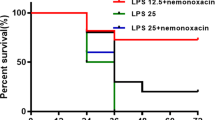Abstract
In a fibrin-clot model of sepsis, developed in mice, treatment with the antibiotics ceftazidime (Cfz) and ofloxacin (Ofl) caused significant (p<0.01) release of endotoxin and TNF-α after 4.5 h when compared with control (untreated) and amikacin (Ami) treated group. Except for control group, the level of bacteremia declined in all three antibiotic-treated groups. The results suggest that antibiotic therapy, irrespective of the agent used, results in an increase in endotoxin levelsin vivo. The amount of endotoxin liberated by Ami was much smaller than with Cfz and Ofl therapy, which makes it an appropriate agent for the treatment of sepsis. An increase in the level of TNF-α along with endotoxin is suggestive of increased inflammatory response.
Similar content being viewed by others
References
Atkinson B.A.: Species, incidence trends of susceptibility of antibiotics in the United States and minimum inhibitory concentrations, pp. 607–618 in V. Lorian (Ed.):Antibiotics in Laboratory Medicine. Williams and Wilkins, Baltimore 1980.
Bingen E., Goury V., Bennani H., Lambert-Zechvsky N., Aujard Y., Darbord J.C.: Bactericidal activity of β-lactams and amikacin againstHaemophilus inluenzae: effect on endotoxin release.J.Antimicrob.Chemother. 30, 165–172 (1992).
Casey L.C.: Antibiotics: more than just “bug” killers.Crit.Care Med. 25, 1–8 (1997).
Chhibber S., Aggarwal S., Yadav V.: Contribution of capsular and lipopolysaccharide antigens to the pathogenesis ofKlebsiella pneumoniae respiratory tract infection.Folia Microbiol. 48, 699–704 (2003).
Crosby H.A., Bion J.F., Penn C.W., Elliott T.S.: Antibiotic-induced release of endotoxin from bacteriain vitro.J.Med.Microbiol. 40, 23–30 (1994).
Demarsh L.P., Wells G.I., Lewandowski T.F., Frey C.L., Bhatnager P.K., Ostovic E.J.: Treatment of experimental Gram-negative and Gram-positive bacterial sepsis with hematoregulatory peptide SK and F107649.J.Infect.Dis. 173, 203–211 (1996).
Giamarellos-Bourboulis E.J., Adamis T., Laoutaris G., Sabracos L., Kaussoulas V., Mouktaroudi M., Perra D., Karayannacos P.E., Giamarellon H.: Immunomodulatory clarithromycin treatment of experimental sepsis and acute pyelonephritis caused by multi-drug resistantPseudonanas aeruginosa.Antimicrob.Agents Chemother. 48, 93–99 (2004).
Horri T., Kobayashi M., Sato K., Ichiyama S., Ohta H.: Anin vitro study of carbapenem induced morphological changes and endotoxin release in clinical isolates of Gram-negative bacilli.J.Antimicrob.Chemother. 41, 435–442 (1998).
Horri T., Ichiyama S., Ohta M., Kobayashi M.: Relationship between morphological changes and endotoxin release induced by carbapenems inPseudomonas aeruginosa.J.Med.Microbiol. 48, 309–315 (1999).
Hurley J.C., Louis W.J., Tosoloni F.A., Carlin J.B.: Antibiotic-induced release of endotoxin in chronically bacteruric patients.Antimicrob.Agents Chemother. 35, 2388–2394 (1991).
Jackson J.J., Kropp H.: β-Lactam antibiotic-induced release of free endotoxin.In vitro comparison of penicillin binding protein (PBP) 2-specific imipenem and PBP-3-specific ceftazidime.J.Infect.Dis. 165, 1033–1041 (1992).
Kiener P.A., Marek F., Rodgers G., Lin P., Warr G., Desiderio J.: Induction of tumor necrosis factor, IFN-α and acute lethality in mice by toxic and non-toxic forms of lipid A.J.Immunol. 141, 870–874 (1988).
Kmoníčková E., Zídek Z.: Quantitative aspects of lipopolysaccharide and cytokine requirements to generate nitric oxide in macrophages from LPS-hyporesponsive (Lps d) C3H/HeJ mice.Folia Microbiol. 49, 737–745 (2004).
Hreger B.E., Craven D.E., McCabe W.R.: Gram-negative bacteria. IV. Re-evaluation of clinical features and treatment in 612 patients.Am.J.Med. 68, 344–355 (1980).
Labro M.T.: Interference of antibacterial agents with phagocyte functions. Immuno-modulation or “immuno-fairy tales”.Clin.Microbiol.Rev. 13, 615–650 (2000).
Mayeus P.R.: Pathobiology of lipopolysaccharide.J.Toxicol. 51, 415–435 (1997).
Medzhitov R., Janeway C.A. Jr.: Decoding the patterns of self and non-self by the innate immune system.Science 296, 298–300 (2002).
Mingeot-Leclercq M.P., Tulkens P.M.: Minireview: aminoglycosides nephrotoxicity.Antimicrob.Agents Chemother. 43, 1003–1012 (1999).
Moller A.S., Ovstebo R., Westvik A.B., Joo G.B., Hang K.B., Kierulf P.: Effects of bacterial cell wall components (PAMPs) on the expression of monocyte chemo-attractant and protein-1 (MCF1), macrophage inflammatory protein-1α (MIP-1) and the chemokine receptor CCR2 by purified human blood monocytes.J.Endotoxin Res. 9, 349–360 (2003).
Ngeleka M., Beauchamp D., Tardif D., Auclair P., Gourde P., Bergeron M.G.: Endotoxin increases the nephrotoxic potential of gentamicin and vancomycin plus gentamicin.J.Infect.Dis. 161, 721–727 (1990).
Parrillo J.E.: Pathogenetic mechanisms of septic shock.N.Engl.J.Med. 328, 1471–1477 (1993).
Prins J.M., Sander J.H., Deventer V., Kuijper E.J., Speelman P.: Minireview: clinical relevance of antibiotic induced endotoxin release.Antimicrob.Agents Chemother. 6, 1211–1218 (1994).
Raetz C.R.H., Ulevitch R.J., Wright S.D., Sibley C.H., Ding A., Nathan C.F.: Gram-negative endotoxin: an extraordinary lipid with profound effects on eukaryotic signal transduction.FASEB J. 5, 2652–2660 (1991).
Rudbach J.A., Akiya F.I., Elin R.J., Hochstein H.D., Luoma M.K., Milner F.C.B., Milner K.C., Thomas K.R.: Preparation and properties of a national reference endotoxins.J.Clin.Microbiol. 1, 1272–1274 (1976).
Silverstein R., Wood J.G., Xue Q., Norimatsu M., Horn D.L., Morison D.C.: Differential host inflammatory response to viableversus antibiotic killed bacteria in experimental microbial sepsis.Infect.Immun. 68, 2301–2308 (2000).
Simon D.M., Koening G., Tenhalme G.M.: Differences in release of tumor necrosis factor from THJP-1 cell stimulated by filtrates of antibiotic killedE. coli.J.Infect.Dis. 164, 800–802 (1991).
Toky V., Sharma S., Arora B., Chhibber S.: Establishment of a sepsis model following implantation ofKlebsiella pneumoniae-infected fibrin clot into the peritoneal cavity of mice.Folia Microbiol. 48, 665–669 (2003).
Author information
Authors and Affiliations
Rights and permissions
About this article
Cite this article
Toky, V., Sharma, S., Bramhne, H.G. et al. Antibiotic-induced release of inflammatory mediators from bacteria in experimentalKlebsiella pneumoniae-induced sepsis. Folia Microbiol 50, 167–171 (2005). https://doi.org/10.1007/BF02931467
Received:
Revised:
Issue Date:
DOI: https://doi.org/10.1007/BF02931467




